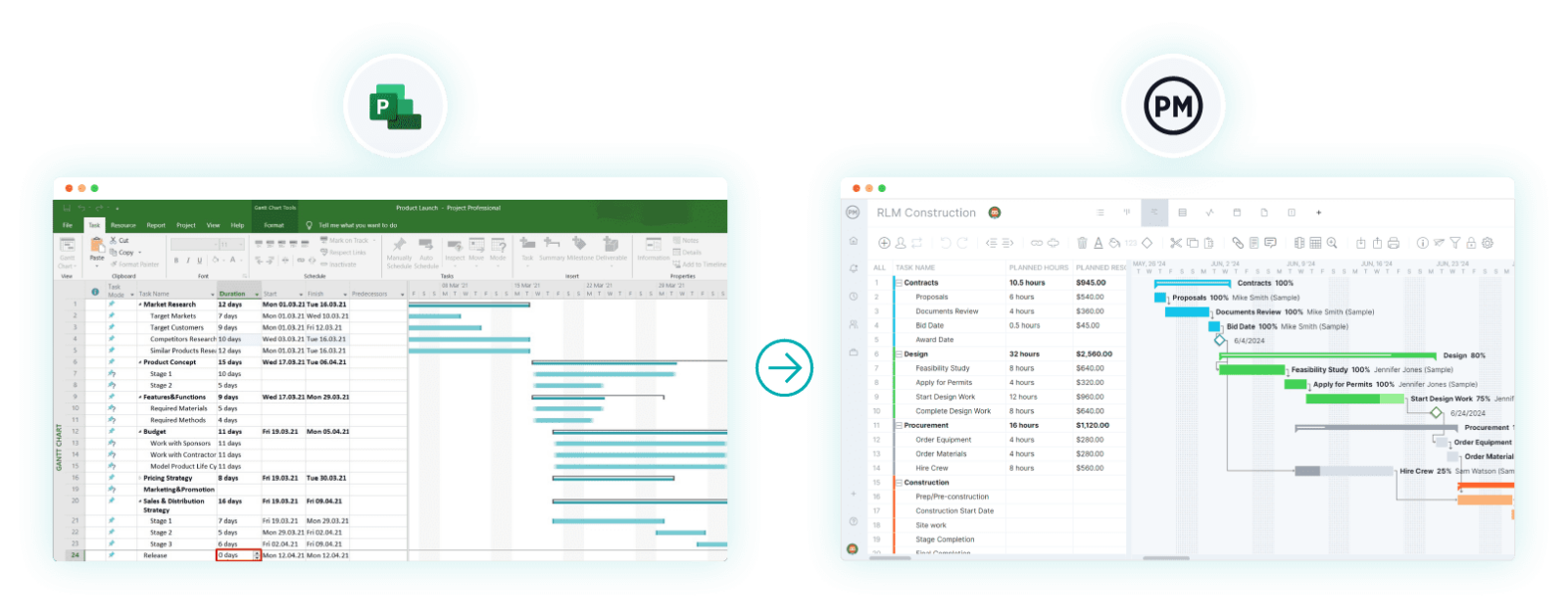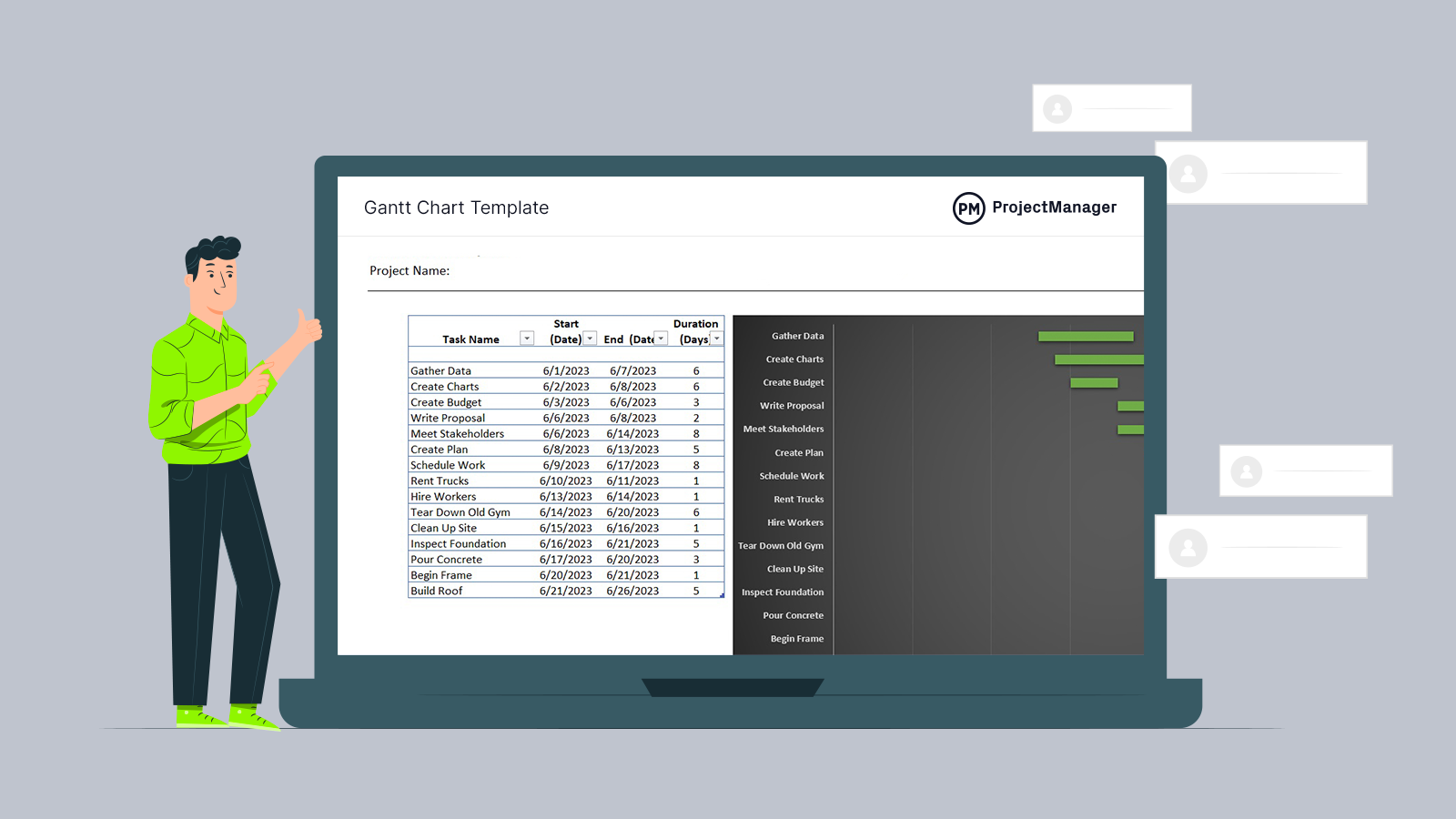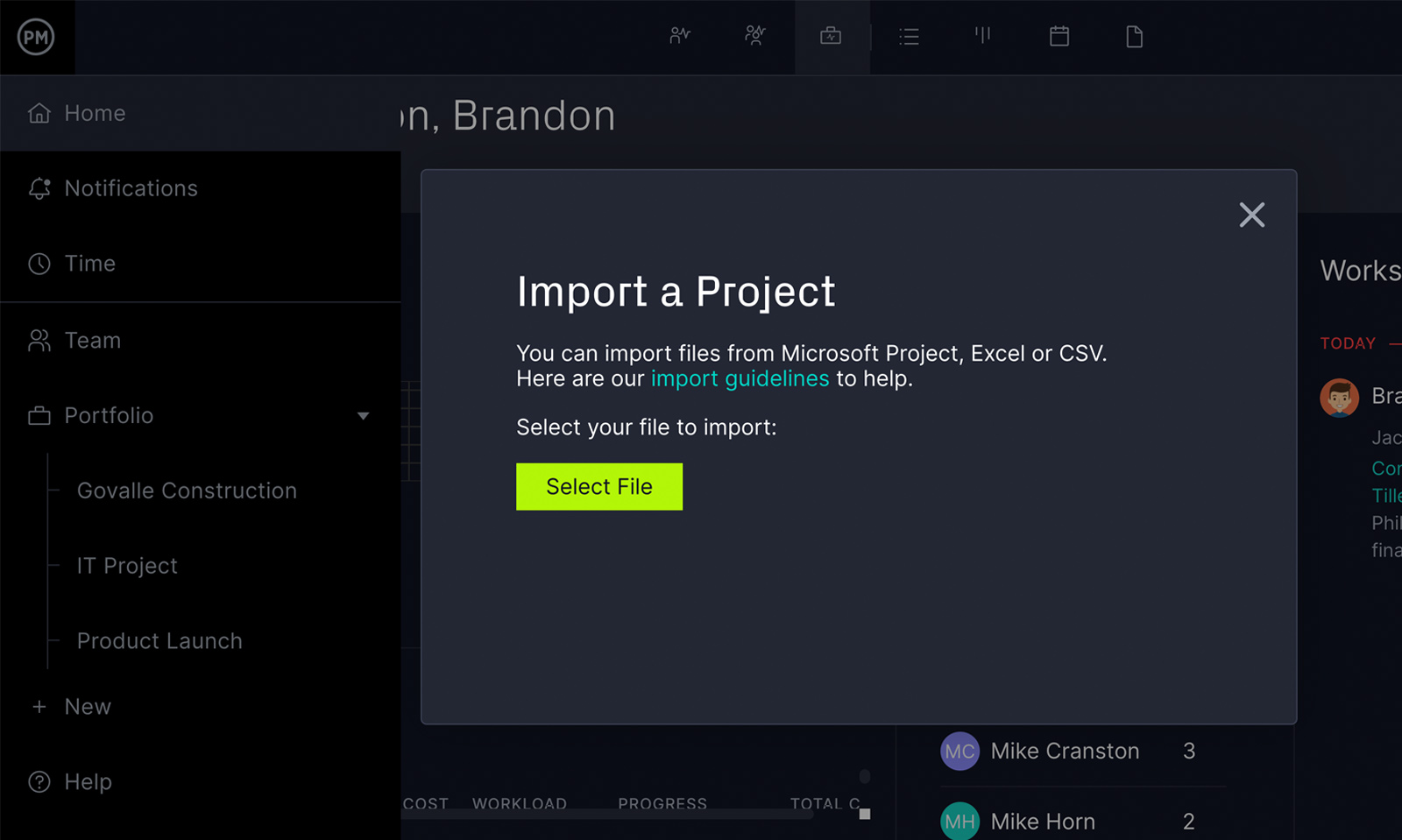Microsoft Project is used by many project managers, especially at large organizations where it’s legacy software. But MS Project can be difficult to use. So, how do you use Microsoft Project? Our guide goes through a step-by-step process to help you maneuver through the byzantine program.
See if Microsoft Project is right for you. If not, it might be time to explore a Microsoft Project alternative.
ProjectManager, for instance, is a Microsoft Project alternative that offers nearly all the same features as Project in a modern, easy-to-use platform. Collaborate with your team using Gantt charts, kanban boards, dashboards, roadmaps and more. You can even manage and track your resources in real time: Project can’t do that. Start today for free.

Starting a Project in Microsoft Project: Tasks and Durations
Once you’ve downloaded Microsoft Project and opened it up on your desktop, you can start entering data into the task plan of the Gantt chart, such as the task name and its duration.
As you enter tasks and durations in the spreadsheet to the left, you’ll see it graphically represented to the right in a blue bar over a timeline in the Gantt chart. This is called the taskbar, and it’s a great way to get a quick visual of what tasks need to be done and when.
Once all your tasks have been entered into the spreadsheet and reflected on the Gantt chart to the right of your screen, remember to save the project. Give it a name and place it in a folder. It’s a good idea to number this file to distinguish it from the newer versions you create as the project progresses. The file will be saved with the extension MPP.
Project Start Date and Task Dependencies
MS Project defaults to starting all your tasks on the same date, so you have to now tell the program when each task starts. You do this by clicking on the Project item on the top bar and then Project Information in the dropdown menu. A new window will pop up and you can now change the start date.
Microsoft Projects allows you to note task dependencies, such as when one task cannot start until another is finished. You want to manage these task dependencies, so MS Project gives you the ability to link them. One way is on the Gantt chart by hovering your mouse in the center of the taskbar. The cursor will become a four-way arrow, which by clicking left will allow you to drag one task over another, linking them. Now save the file, and mark it as version two.
Creating Milestones in MS Project
A milestone marks the end of a phase of the project, and they’re a good way to track your progress and stay on schedule. You’ll want to add these to your Gantt chart. To make a task a milestone, click on the task. Once it’s highlighted, right-click to bring up the task information window.
Click on the Advanced tab. There will be a checkbox at the bottom left. All you have to do is check this box and the task will now be designated as a milestone. You will see it on your Gantt chart as a black diamond shape. Don’t forget to save.
Toolbar and Icons in Microsoft Project
The toolbar option is in the View menu, which allows you to choose the view you want: Gantt chart, calendar, network diagram, task usage, tracking, etc. You can now pick the view that is most relevant to you, which will change throughout the project, so you’ll be using this feature often.
There is also a Toolbar option under view, which will open up another window to the right with more options. The Standard and Formatting options are defaults, but you can change these as you like to see what you want to see at any particular time. Using Microsoft Project does give you a fair amount of control over how you see the project.
The icons on the toolbar offer a popup screen tip if you hover your mouse over them, which can be helpful it familiarizing yourself with the visual vocabulary of MS Project. The icons should be commonplace to anyone with some computer literacy: New File, File Search, Print Preview, Spelling, Undo, etc.
You should look around and get to know all the various functions and formatting options the software offers. Once you have, you can customize the toolbar by removing or adding options. On the right of the standard toolbar is a small double arrow and a small down arrow, which can be used to customize your toolbar.

Get your free
Gantt Chart Template
Use this free Gantt Chart Template for Excel to manage your projects better.
Sharing Microsoft Project Files
Learning how to use Microsoft Project is a project in itself. It’s a huge program and like turning a tanker ship, you have to have patience and give it time. If you invest some, you’ll get a nice project management tool to help you manage your projects. However, when it comes to sharing files with your team, you may find yourself frustrated with no easy solution other than buying more MS Project licenses.
There are, of course, workarounds for those of us who don’t have a Microsoft Project license but still need to work with and share MPP files. Most common is the plethora of MS Project viewers available online. These allow you to view files, but most don’t give you the ability to work on them.
ProjectManager For Working on MPP Files Online with Your Team
ProjectManager is the exception because our online project management tool can import MPP files and then give you all the features you need to edit the file, offering even more options than Microsoft Project. This makes us an excellent alternative to Microsoft Project, or at least a software to use in tandem with MS Project.
MS Project isn’t easy to share online. Its files are too big and cumbersome. But it’s easy to do with ProjectManager’s integration with Microsoft Project. There are multiple features in ProjectManager that not only allow you to view and share MPP files but there’s also roundtripping, which maintains your changes and format from one program to the other.
In terms of features, we have award-winning Gantt charts that function just like MS Project, and a real-time dashboard that gives you an accurate and timely window into the progress of the project. There’s also a timesheet and workload management to help you track time right alongside the project. And we offer online PM tools that foster collaboration with your team.
If you just need access to MPP files, then you should take a look at ProjectManager. As noted above, it’s more than just a tool to view your MS Project online, but gives you access to work on the files and save them without losing any of your work.
How to Import Your Microsoft Project Plan into ProjectManager
Now that you understand the basics, it’s time to see how seamlessly ProjectManager works with MS Project and how as a standalone tool we’re a one-stop-shop for all your project management needs. Here’s a quick tutorial on getting your MPP file into our software.
Sign up for a free trial and follow the steps to get your Microsoft Project files into an online, collaborative tool.
Start the Process
Get started by selecting the Gantt project view. There you’ll see an import button that looks like a box with an arrow through it. Just click it.
Which File Do You Want to Import?
See the popup window? It wants to know the file you’d like to import. Choose it and then click Next.

Pick File Options
Find the import options on the new popup window, such as whether you’d like to import the MPP file to a new project or an existing one. Then decide whether to keep or replace the data.
Do You Want Everything or Just the Task List?
Next, decide if you want to import all the data or just the tasks. Once you’ve selected that, click next.

Start Working!
Begin sharing and editing your MPP file. You’ll notice we keep your customization, and when you export it, any changes will carry with the file back to MS Project.

Whether you use Microsoft Project or not, ProjectManager is a great workaround for that bulky program, especially if you need Microsoft Project for Mac. We’re leaner and online, so you can share easily. ProjectManager is also a great alternative to MS Project, offering nearly the same features, but is more user-friendly, sharable and without the excessive cost and learning curve. See for yourself by taking this free 30-day trial.
Related Content
- Microsoft Project: Plans, Training and How to Download
- Best Microsoft Project Alternatives
- Best Microsoft Planner Alternatives
- What Is Microsoft Project? Uses, Features and Pricing
- Microsoft Project Online: Pros, Cons and Free Alternatives
- Microsoft Project Viewer – How to View & Edit MPP Files Online
- MPP File Extension: What Is It & How to Open It
- Microsoft Project for Mac: How to Run MS Project Files on Your Mac

